The UK’s next generation anti-submarine warfare fleet is on schedule for the first in class entering service in 2028, according to a written parliamentary answer from Defence Minister Luke Pollard.
Pollard confirmed that “the Type 26 programme remains on track to meet all user requirements and deliver eight world-class anti-submarine warfare frigates in time to replace the anti-submarine warfare Type 23s.”
All eight ships are expected to enter Royal Navy service between 2028 and 2035, forming the backbone of the fleet’s anti-submarine capability for the coming decades.
Pollard added that “Type 26 frigates will allow the Royal Navy to continue to play a leading role in the anti-submarine theatre of the North Atlantic, providing a crucial output to both NATO and the Joint Expeditionary Force.”
The Type 26, or City-class, is designed as a highly capable multi-role warship optimised for anti-submarine operations while supporting air defence and general-purpose missions. Developed under the Global Combat Ship programme, the design replaces the ageing Type 23s and forms the basis for export variants for Australia, Canada, and Norway.
It is the first shared warship design between the three Commonwealth nations since the pre-war Tribal-class destroyer, symbolising renewed industrial and operational alignment among key allies.
Each ship displaces roughly 8,000 tonnes, measures 150 metres in length and has a range exceeding 7,000 nautical miles. Its combined diesel-electric and gas turbine propulsion provides speeds above 26 knots, with advanced acoustic quieting for submarine-hunting operations.
The combat system integrates the Artisan 3D radar, Sonar 2087 towed array, Type 2150 bow sonar, and the Mk 41 Vertical Launch System capable of deploying the Future Cruise/Anti-Ship Weapon. The class will also be equipped with a 5-inch Mk 45 naval gun, Sea Ceptor missiles, and Phalanx CIWS for close-in defence.
The ships feature a mission bay for modular payloads and a Chinook-capable flight deck supporting Merlin or Wildcat helicopters and uncrewed systems. Construction is led by BAE Systems in Glasgow, where HMS Glasgow and HMS Cardiff are in fitting out, HMS Belfast is under construction, and Batch 2 ships, Birmingham, Sheffield, and Newcastle, are progressing through early build.


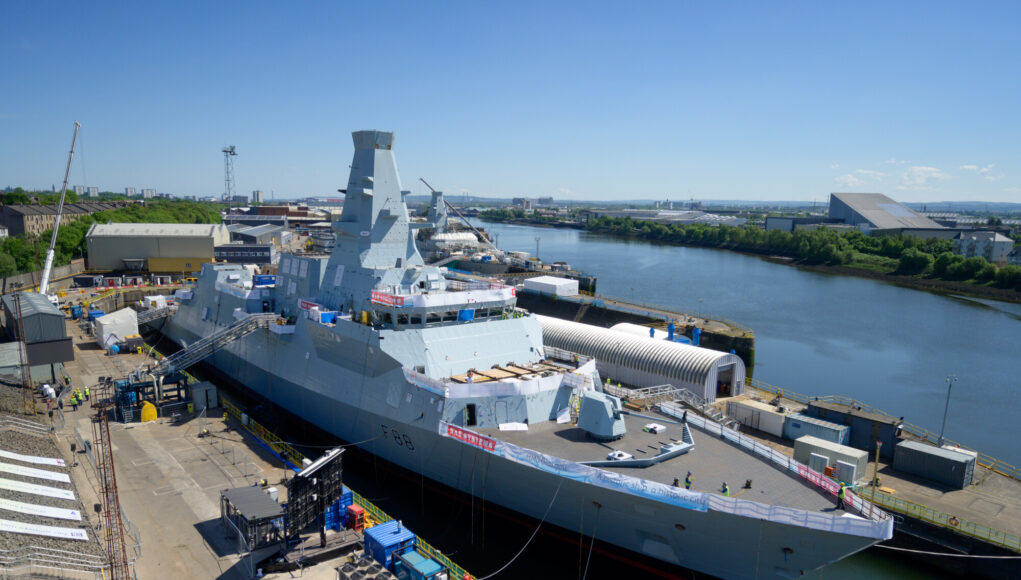
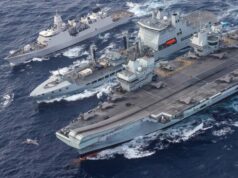
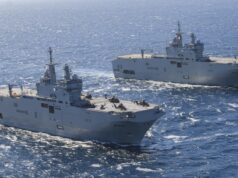

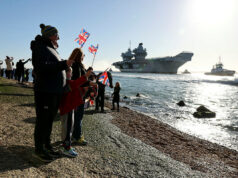


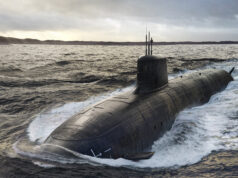
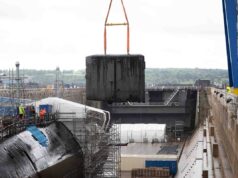
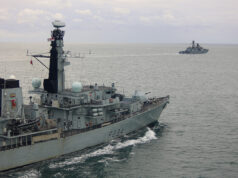


Man, that’s been a slow burn – seem to recall they cut steel on theses in 2017? I look forward to a MOD commitment to get on with the Type 32 !
You’re funny
that’s what me mum says!
Type 32… ho ho ho Christmas soon.
Yep. We built the battleships Nelson and Rodney in half the time…
“In time to replace” my ass!!
Laughable
Windows in on the bridge by the looks of it …. slowly but surely! Can we see the assembly hall in the distance on the main picture here George, or is this off the picture to the left?
The picture was taken in May, so progress maybe a bit faster than you’d think?
That’s a poky looking helicopter hangar for a ship of this size.
It fits a Merlin? What else do you want
He just wants to complain, it’s utterly endemic on this site of hadn’t you noticed?
Two Merlins? A Merlin and a Proteus? Nice to have a bit of flexibility, don’t you think?
You’d never get 2 Merlin’s side by side
I refer you to my original comment.
Two Merlins fit, one forward of the other.
Although operating two simultaneously might be bit of a challenge., one as backup to the other will work nicely.
Babcocks proposal for the 32, the Arrowhead 140 MNP is claiming to enlarge the hanger to fit 2 Merlins? There’s trade offs of course.
You know you can actually fit two Merlins in a Type 26 hangar right?
Do you have a source for that? It’s not what I’ve heard.
The hangar and mission bay have a combined length greater than two merlins, and a height greater than a merlin and are seperated by a shutter with the same dimensions as the entrance to the hangar. You can fit two Merlins.
I know Navy Lookout published a diagram suggesting you might squeeze a second Merlin into the mission bay, but until someone actually tries it, we don’t know for sure it is possible. And it would have to pass through the hangar space to reach the flight deck.
“We’re going to need a bigger boat”
I believe it’s possible to fit one behind the other, but not side by side. So if the one closest to the stern is broken, you need to somehow get it out of the way to get the forward non broken helicopter out onto the same flight deck (& perhaps take off?), in order to allow the broken one to move forward. Either way this is not as easy as it sounds, especially in unfavourable sea states.
We won’t know until somebody tries it? Ever heard of a tape measure dude?
I don’t think I have a tape measure that extends far enough to measure a Merlin!
43 cubits, 2 feet, 3 hands and 3 thumbs long.. thereabouts
My Fantasy embarked Helicopter combo is a Merlin and a Wildcat – best of both worlds surely 😉.
Yes I don’t understand why they could not get a side by side hanger to be honest.. I suspect it’s because Merlin is so large and they only planned for the small ship flight to be a Merlin.. but in hindsight with the rise of drone warfare.. having a side by side that could take a Merlin + wildcat or medium sized drone would have been more future proof.
The funnels have to be positioned differently thanks to the mission bay, doesn’t leave room for a double hangar
Cheers Hugo.. so we sacrificed hanger space for mission bays.. I wonder if that was the correct compromise ?
Only time will tell, but I would suggest that they have tried to future proof the design. Not an easy task given the rate at which autonomous vehicles are developing.
Cheers CR
Yep indeed.. drone warfare at sea was nothing but a concept when the type 26s were designed.
Not really, you can put two Merlins into the Hangar, it’s just they have to be inline, so you have to have one in the air when you launch the second one.
As I understand it they would need to stick it in the mission bay and it would need to have the first in the air before you can launch the second one so a bit operationally sticky. Not sure if they can do some evolution that involves them being swapped around on the fight deck though.
That is what inline means.
What happens if the first one can’t fly?
Push it out of the way, duh
What overboard?
Tbf to the Navy I don’t think any of the double hangar escorts are designed for 2x Merlin, Seahawk is significantly smaller.
It probably could and should have been done though, even if one of the hangars would be ‘flexible’ and could also (by means of a ceiling mounted handling system) act as a mission bay for a single USV or XLUUV.
Yep I was not thinking two Merlin’s they are huge. But a Merlin and a second rotor in the 4000kg range.
That would make a lot more sense and if we are assuming 1 Merlin = 2 Wildcat = 4 Proteus in terms of hangar space, which seems reasonable, would also allow a lot of ASW helicopters on a frigate.
Those 3 sizes are all we should be working around in the requirements for future vessels, which should be as follows:
T83: Merlin plus Proteus
OPV: Wildcat plus Proteus
MRSS: 4x Merlin or equivalent
T26: Should really have been Merlin plus Wildcat
Proteus is a demonstrator, will not enter service.
The single demonstrator called Proteus won’t but something very like it will.
Why else would Leonardo show lots of different payload modules and modifications?
Merlin + a RUAS the size of the one Leonardo are developing would be a pretty respectable load out for any ASW frigate in the world currently.
I think expecting 2 Merlin is a stretch for any escort to be honest, Navy Lookout had a picture of one on the deck of HMS Prince of Wales next to a Malaysian Super Puma- the SP was small in comparison.
They can take two Merlin if required
That’s not confirmed and they can’t operate them effectively
Not confirmed? The Hangar and mission bay are empty spaces and have a combined length of 35meters, a Merlin folded is 15.7m long, the fact that you can fit two into the space is an objective fact.
That’s not the same as putting two in the hangar, is it? Do you know the width of the doorway between hangar and mission bay? Might the mechanism of the overhead mission bay handling system get in the way of something as large as a Merlin passing between the two spaces? Saying that the length is enough doesn’t mean you can actually operate them the way you suggest.
Might the mission bay handling system get in the way:
No. It doesn’t.
Do you know the width of the doorway between the hangar and mission bay:
The hangar and missionbay aren’t connected by a doorway but by a shutter with the same dimensions as the hangar/flight deck shutter.
Doesn’t change the fact you probably couldn’t even put 2 Merlin’s on the flight deck to swap them around. Not comfortably anyway
Whether you can put 2 Merlins in or not, I don’t think the RN would anyway?
Considering we only have 40 of those invaluable HM2s, and several are needed for ASCS Crowsnest as part of the Carrier dedicated Sqn as well.
Another area cut by HMG, 3 front line Sqns down to only 2, plus 824.
Not even 40, only 30 HM2
Yep, keyboard slip, sorry. 30.
44 HM1.
I think 3 were lost, and 11 HM1 were not upgraded to HM2.
Speaking of cuts, after reading these “how many of what fits in the hangar” discussions, i believe cancellations and cuts for cost savings are not for the cost of the assets but to save money on all the meetings where they argue about what goes where..
CH3 program scrapped to save money.. it was deemed that the 3500 hours of design meetings to discuss how many BV’s could be installed would prove to cost prohibitive..
I never claimed otherwise, in fact I believe if you scroll up you’ll see I said as much.
Tight flaps, spacious inside, what’s not to like?
It’s big enough to fit a Merlin + a RUAS the size of the one Leonardo are developing, which would be a pretty respectable load out for any ASW frigate in the world currently.
I think expecting 2 Merlin is a stretch for any escort to be honest, Navy Lookout had a picture of one on the deck of HMS Prince of Wales next to a Malaysian Super Puma- the SP was small in comparison.
In service by 2035, in time to replace all the type 23’s ?????
What 23 is realisticall still going to be seaworthy by 2035???
Delaying this project so long was almost treasonous!
Cameron really was a waste of space pm
I would lay odds that we will not have a T23 left after 2030 to be honest.. the test will be Kent..if the abandon the refit on Kent.. then you can pretty much write the whole fleet of by 2030.
Now what interests me is not when she enters service but when she becomes operational, because that is the meaningful date.. first in class sea trials will take time. If we look back at HMS Norfolk the first in class for the T23s she entered service on the 1st June 1990.. undertook first in class trials until November 1991 and completed her BOST in December 1991 and her first opperation role was in joint warrior Jan 2022.. she then had a rectifications period and her first deployment in May 1992.
So let’s say Glasgow is handed over and commissioned mid 2028 ( June-Oct for the sake of ).. she will not be operational and deployable until early to mid 2030… at which point if we cannot get any T23s through refit we will have zero T23s.
I suspect (I hope) that you are being a touch pessimistic. The ship looks very nearly complete, and I understand that she will be on ships power very soon, if she isn’t already. I reckon she could be ready for contractors trials in the spring if not earlier. Given the timeline you state for Norfolk then she could be operational in 2028. Alright I am being optimistic. And I think that the OSD for St Albans is meant to be 2035, by which time most if not all of the class should be delivered.
Just a suggestion to George, could we have a regular update on the state of play at the two Scottish shipyards, say quarterly. Many of us are based a long way south but still have a strong interest in how the programmes are progressing. It’s going to be very interesting to see how the Norwegian order impacts the deliveries to the RN from Govan, and also when the first Danish ships are delivered from Rosyth, assuming the contract goes through.
Hi Nick first in class trails for first in class are not the same as the contractors trials. The contractors trial will happen first and after those she will be handed over in 2028 and commissioned..only after this point does the RN undertake its trials and the first in class trials begin and these alway take about 18 months or so.. and alway happen after hand over and commissioning.. the only way for Glasgow to have finished her sea trials and be operational by 2028 is if she begins builder sea trials now and was ready to be handed over to the navy and commissioned in late 2026.
Essentially the builders sea trials are snagging.. the RNs first in class trials are essentially to fully understand the ship, how it works and fights, to write all the how to correctly fight a Type 26..
If you take my Norfolk example I did not include builders sea trials as these had taken place thought the previous year 1989.
In regards to St Ablans that out of service date is dependant on her surviving her post lifex refit which she will have around 2029.. she cannot go to 2035 without this post lifex refit.. the problem is every single T23 that has hit that post lifex refit has ended up being scrapped.. not one of then has been successfully refitted and returned to service.. this is why HMS Kent is the test.. because she has just gone in for her 6 year post lifex refit, if they turn around and say Kent cannot be economically refitted she will join a list of type 23s that have found to be beyond economic repair at the six year post lifex refit point and you can say that it’s very very unlikely any of the T23s will every get beyond 6 years post lifex.
Comprehensive reply for that time of night, thank you! Let’s hope I’m the one that is optimistically correct, but I am not holding my breath!
Yes indeed, it would be a relief to see Kent back in service in 2027 as well as both a T26 and a T31 handed over and on their first in class trials.. with Richmond just finishing a successful refit ready to go back to the fleet in 2028..
T23 were never designed to last this long. They were designed for a 18-20 year lifespan. All surviving T23 are older than that already & they have been very active ships. Most nations build warships with a 30 year design life. Politicians believe all warship should last 30 years because everyone else’s does. The idiots that decided 18-20 years would allow new ships to be acquired rather than expensive mid life refits forgot that they would not be around to ensure it happened. These refits are failing because they are way past any margins built into the design (engineers normally build in a margin for error). If you stretch out a 30 year design life warship to 40 years, you have added 33%, do the same to a T23 & you end up at around 25-26 years.
Yep utter stupidity unfortunately.
Contractors’ trials due to start end 25/early 26. Handover to RN by end 2026. IOC sometime in 2028. All 8 in service by 2035.
Thus spoke UKDJ on 5/12/2024, so it must be true.
It would be nice if they were still on that timeline…
The term is nicely ambiguous. By in service, modern governments mostly mean operational, but allow themselves the leeway to point to the commision date, the handover date, or whatever is most convenient if it all goes wrong.
I suspect if she was being handed over ( commissioned ) before 2028 they would be using that date.. vagueness tends to be used for less good news not good news😂
AFAIK Glasgow was due to start trials this year, but has been delayed til next, so IOC is now slated for ’28, giving at least 2 years for completion of FOC trials. 2 years should be enough to get this on time, no?
The dates for the subsequent boats’ IOCs seem odd though, as they neatly form up annually, but surely this should happen faster if their ST don’t last as long as FOC – or perhaps their construction/fit out has been given extra room for manoeuvre if any issues detected in FOC trials need to be fixed further left in the process
All depends on when it starts contractors trials really.. we will know the likely in service date from then
So as soon as it’s starts the contractors trials you can safely say it’s 14-18 months from commissioning and once it’s commissioned around 18 months for First in class trials before declaring IOC.. then it will pop back for any remedial work ( say 3 months if no serious issues crop up) then it will be off on its first major deployment…
So let’s say they are ready to start ship builders trials in April 2026 if it all goes nice and smooth it will be handed over and commissioned June 2027 the RN will the do their first in class trails for around 14- 18 months. Which will give it an IOC of early doors 2029. Pop it back for remedial work and then out for deployment in June 2029.
I wonder will Venturer enter FOC faster as she seems to be a less complex warship, less systems to work up and trial.
It looks like the new unarmed, initially new frigates will need escorts from those sneaky ruskies spying ears?
That’s why the RN could of done with a off-the-shelf purchase of more escort vessels like LCS?
I understand we have a requirement for an ASROC type weapon, but no progress in that area yet?
They were looking into the possibility of an ASROC type of Weapon, I’m not holding my breath to be honest.
In slightly related news, I see New Zealand seem to be focusing on the Mogami for their new ships rather than the 31, which makes sense given the RAN is going for it. Naval News has an article on it but I won’t link it as that seems to end up stuck in a moderate queue.
I’m not sure that will go anywhere to be honest.. ordering 2 Mogami at present prices would be about a billion pounds.. NewZealand is essentially looking for 2 cheap frigates and as well as a couple of common hulled patrol ships and I suspect they will want all four and a big chunk change from a billion.
As well as the 8 type 26 for the RN from 2028 to 2035 which implies one per year there also needs to be five for Norway starting in 2030 and also running at around one per year.
This means assembly in the Janet Harvey hall in 12 months.
I think this would be possible if enough blocks can be constructed elsewhere to feed the production line.
The bottleneck I see is at scotstoun for fitting out. Can each vessel be fitted out in a year in one of the two dry docks in use?
That might be problematic, but there is a third dry dock on site which is a bit too short as far as I can tell using Google maps.
Will there be a program to extend this third dry dock to give more flexibility in the fitting out program from 2029-30
There is time to do it if things are already been looked at.
An alternative might be to cover the drydocks to allow 24 hour working which would speed up some operations.
Martin, it is not only the RN/RNoN T26s to have the first of the T83s by 2038 which seems to be the plan we would need to place long lead orders in 2029-2030 and fist steel cut in 2030-2032. Things are going to be a bit tight in the build hall. Yes I know I am making the assumption that BAE would get the T83 order. This is based on the fact that the main item on the T83 would be its radar suite which would seem likely to come from BAE then it is logical that BAE will be lead in the T83 program.
3rd dry dock makes sense. Covering them even more so and maybe lengthen the middle one first.
This is fantastalisticallly brilliant news and testamount to the skills and planning efforts and foresight we have come to expect during these testing times, I shall look forward to the Champers bottle being smashed in the years that follow.
Having 3 Merlins (2 in the hanger and one on deck) will be a great capability too and having all 8 ships at sea patrolling our AOI’s with such State of the art, World leading Ships will Make Britain Great (again) (MBG) add those state of the art Gas Turbines (GT’s) and we have a winning vehicle once more.
All hail the MGB GT.
I assume you’re joking about 3 merlins
Well aparently you can get two in the hanger so that leaves the Helideck, so by my Maths, that’s 3.
I’m not as Stupid as people think !
Again, you’re just having a laugh right? Cause you have to actually get the other 2 out of the hangar, in fact even 2 is untenable
Get with the plot mate, i’m being sarcastic as usual !!!
Hugo.
Halfwit is the resident Jester, although his performances are for the UKDJ benefit, not court!
You have totally miss counted.. because a Merlin has a 5-6 hour endurance so say you keep up a sortie rate of 1 per hour you can have 4 in the air and 3 on the ship. Clearly they may have to beef up the mission bay crane just incase they have a bit of a miscalculation and need to recover a ditched Merlin or two..
Well my first T22 had 2 Lynx in the Hangar and at one point a wessex 5 on deck and another time a Sea king… Anything is doable if you need it to be…then again we where down south and pretty much all the rules went out the window.
That said another T22 had a Gulf MOD Lynx, a rear lynx in the Hangar and we had a Gazelle land on.
… Yes it had skids… That was the Adriatic and again the rules went out the window.
Let’s take a moment to consider …….over 10 years to build 1 ship , does anyone else find that a bit ridiculous .
Not really considering how many matchsticks are involved.
It also takes a long time to get it through the neck of the bottle.
I’ve yet to meet a Scotsman who had any problem “Necking from a Bottle”.
Totally ridiculous.
Even more ridiculous that Glasgow is nearly finished, but it will be another 3 years to commission.
If you look at the timelines for previous designs T42/22/23 they were around 5 years from steel cut to commission for first in class. then averaging about 3.5 years for rest of the class.
So what are we doing differently today? I suspect it is poor project management.
People will argue that T26 is more complex than what has gone before, but you can say that bout any first in Class
I wouldn’t put it all down to poor PM, but also to the Government stalling so long in the order and wanting it stretched out as much for budget reasons.
HMS Norfolk took two years between handover, Nov ’89, and being declared fully operational in Dec ’91. HMS Daring only took about 18 months, but she’d taken another 18 months on manufacturer’s sea trials before handover in December ’08. [I doubt T26 will take longer than nine months.] HMS Broadsword was called into service while still in sea trials for the large rescue operation required after storms struck the 1979 Fastnet race, so that doesn’t count. However you have a point about earlier ships. so let me cut and paste a paragraph about the lead T42, HMS Sheffield, commissioned in 1975. I think it gives a clue as to why many of the earlier Cold War ships were not trialled for as long as two years before being classed as operational.
“As the first of her class of Royal Navy destroyers, Sheffield spent her first years trying out the new systems and the Sea Dart missile system, particularly as the intended Sea Dart trials ship, HMS Bristol, suffered serious fires and problems with its steam systems restricting its use in the late 1970s. It was not until 1980 that Sheffield became effective, with Sea Dart and partial installation of electronic warfare Abbey Hill systems.”
The first in class used to be thought of as a prototype and we could afford to ease them into service. We had a huge fleet, and other than trying things out, turning up at Naval Reviews and joining large NATO exercises, first in class didn’t always see much action on commissioning. If we had a similar concept of operational to now, it’s not reflected in the official dates. These days we no longer have that luxury and ships have to perform from the get go, even first in class. They have to be fully tested and worked up; scrimping on the testing does nobody any favours.
Nothing to do with poor PM, it’s the slow dribble of money from the Treasury that’s slowing everything down. All Geo Osborne’s idea. Big dufus.
I read that is down to HMG and drip feeding money.
Should have read this before posting my previous comment. Sorry.
No worries mate.
Given how slow the T26 rollout is and the train crash of T23 availability I can but wonder why the UK is not realising it needs to improve ASW on it other surface warships eg T45 and upcoming T31. Clip on arrays or such either on ship or offboard them. T45 could horror even have a sonar ipgrade ( and even man them!) At the very least this should have been tested. Then there is getting Flash sonar for some Wildcats etc.
I think it does realize it needs extra capacity but the chosen route is to add two low or zero crews vessels to work with each type 23 – 26 as a team controlled by staff on the T23 , T26.
With today’s technology it’s easy to have remotely controlled engine rooms, fire fighting, navigation and steering, weapons operation.
What is more difficult and which would make sense to speed up introduction is things like interacting with crews of other vessels, deploying towed sonar arrays, entering and leaving port which is why I think going for low crew first would be the safest option for a quick deployment.
A much better value for money investment than trying to get vessels not designed for sub hunting upgraded and reducing their availability for other uses.